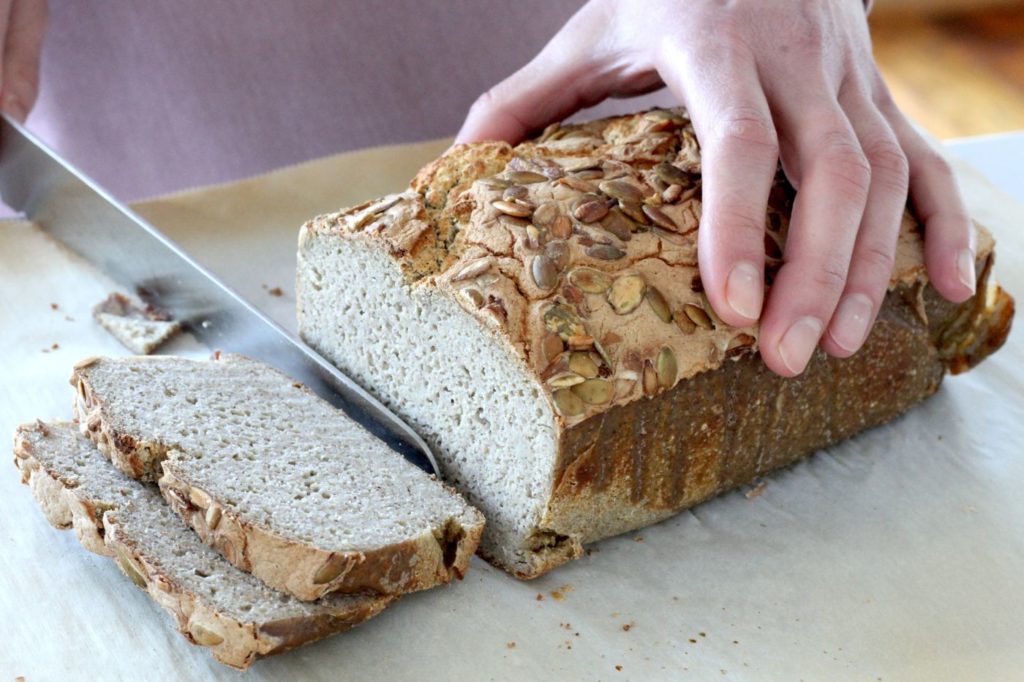
This is an easily digestible, vegan, gluten-free, and yeast-free recipe for delicious, wholesome bread suitable for bakers of any experience!!
I am a big fan of ferments and after making my first loaf of the Fermented Buckwheat and Quinoa Bread I fell in love with the process. Over the past two years I have been experimenting with various combinations of pseudograins and came up with another satisfying flourless homemade bread! Fermented, mildly sour, this method is simple, but it requires patience.
About the Ingredients
MILLET
Millet has a creamy, mild flavour (not overbearing like quinoa or buckwheat). This gluten-free ancient grain is rich in magnesium and calcium. Just one cup (100g) of cooked millet grain delivers 20 per cent of the recommended daily intake (RDI) of magnesium and 13 per cent of the RDI of calcium.
Magnesium is essential for hundreds of biochemical pathways in the body; it supports muscle contraction and relaxation and thus plays an important role in exercise and athletic performance. It can help with blood glucose regulation, reducing demands on insulin and nutritionally is indicated in type-2 diabetes and gestational diabetes mellitus (during pregnancy). Among many other incredible supportive factors, magnesium has powerful cardiovascular benefits, with studies showing that higher magnesium intake can help reduce blood pressure levels.
WILD RICE
When compared with other whole grains, such as wheat and brown rice, wild rice comes out ahead in the minerals potassium and phosphorus as well as the B vitamins niacin, riboflavin and thiamine.
Wild rice benefits include its ability to improve heart health, stimulate growth and repair throughout the body, slow the signs of aging, protect against chronic diseases, prevent the onset of diabetes, optimize the digestive process, strengthen your bones, boost your immune system, and help with weight loss efforts.

Gluten- Free Fermented Millet Bread
Ingredients
- 2 cups whole millet
- 1/4 cup wild rice
- 1/4 cup flax seeds
- 1/2 - 1 tsp salt quality unrefined sea salt or Himalyan salt
- 2 3/4 - 3 cups filtered water
Optional
- Coconut oil for greasing pan or parchment paper
- sunflower seeds or pumpkin seeds
Instructions
- First, rinse millet, wild rice and flax seeds, in a colander under cold running water.
- Put all rinsed ingredients into a large glass or ceramic bowl, add sea salt and purified water - the water should just cover the mixture.
- Place a cheesecloth or a clean dish towel on top of the bowl and let it sit at room temperature for 24-48 hours to ferment. (refer to video for details).
- Next transfer the soaked mixture (do not drain) into a high-speed blender or food processor, add more sea salt (if desired). Blend for at least 1-2 minutes or until there are no more visible pieces of grains and it resembles pancake batter-like consistency.
- Pour the batter into a glass or silicone loaf pan lined with parchment paper (or greased with coconut oil), and if desired sprinkle the top of the loaf with seeds.
- Place the bread into warm (not hot!) oven and let it rise for another 7 hours or overnight. No need to preheat the oven - simply put a large glass filled with hot water inside the oven.
- Next, preheat oven to 410 degrees and bake for 1 hour.
- Remove from oven and if you used parchment paper, you can remove the bread from pan immediately and place it on a cooling rack. Allow the bread to cool for at least 1 hour before slicing. Once completely cool, slice bread, enjoy as is or toasted.
Notes
Dedicated to your health & wellbeing,


